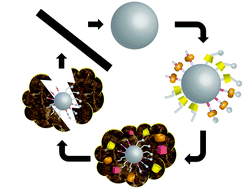Time and time again humanity is faced with a unifying global crisis that crosses the many great divides in different societies and serves to bring once segregated communities back together as a collective whole. This global community instinctively turns to science to develop the means of addressing its most pressing problems. More often than not, these forces dictate the direction that scientific research takes. This influence is no more apparent than in the field of supramolecular chemistry where, for decades now, its responsibility to tackle such issues has been put on the back burner as a consequence of a lack of platforms with which to deliver this contemporary brand of chemistry to meaningful applications. However, the tide is slowly turning as new materials emerge from the field of nanotechnology that are poised to host the many attractive attributes that are inherent in the chemistry of these supermolecules and also in the mechanostereochemistry of mechanically interlocked molecules (MIMs), which can be reused as a sequel to supramolecular chemistry. Mesoporous silica nanoparticles (SNPs) have proven to be supremely effective solid supports as their surfaces are easily functionalised with either supermolecules or MIMs. In turn, the blending of supramolecular chemistry and mechanostereochemistry with mesoporous SNPs has led to a new class of materials – namely, mechanised SNPs that are effectively biological nanoscale ‘bombs’ that have the potential to infiltrate cells and then, upon the pulling of a chemical trigger, explode! The development of these materials has been driven by the need to devise new therapies for the treatment of cancer. Recent progress in research promises not only to control the acuteness of this widespread and insidious disease, but also to make the harsh treatment less debilitating to patients. This global scourge is the unifying force that has brought together supramolecular chemistry, mechanostereochemistry and nanotechnology, uniting these three communities for the common good. At the nanoscale level, the mechanism for the release of cargos from the confines of the nanopores in the SNPs is accomplished by way of mechanical modifications made on the surface of these functionalised supports. These mechanical motions rely on both supramolecular, i.e., host–guest complexes, and mechanostereochemical phenomena (e.g., bistable rotaxanes), which are often stimulated by changes in pH, light and redox potentials, in addition to enzymatic catalysis. The future of this field lies in the development of ‘smart bombs’ wherein the loaded mechanised SNPs are endocytosed selectively by cancer cells, whereupon an intracellular trigger causes release of a cytotoxin, effectively leading to apoptosis. This review serves to highlight (1) the evolution of surface-functionalisation of SNPs with supermolecules and also with MIMs, (2) the mechanisms through which controlled-release of cargo from mechanised SNPs occurs, and (3) results from the in vitro application of these mechanised SNPs.


 Please wait while we load your content...
Please wait while we load your content...